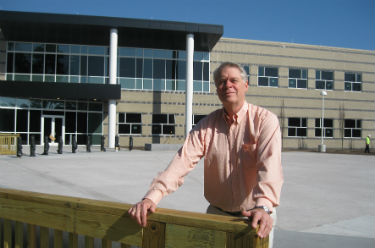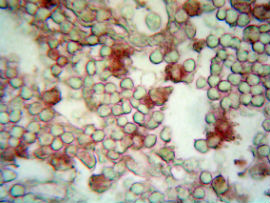 Dan Baden cultures the brevetoxin at the Center for Marine Sciences on the UNCW campus. Photo: Pam Smith |
WILMINGTON — Stroke is a leading cause of long-term disability in the United States. According to the Center for Disease Control, some 795,000 people suffer strokes each year. And yet, there is no drug treatment for post-stroke rehabilitation.
But that could change thanks to, of all things, marine algae toxins known to kill fish and cause serious respiratory illnesses in humans.
Supporter Spotlight
Researchers are using brevetoxin-2, a neurotoxin produced by marine algae, to stimulate nerve cell growth and increase plasticity for existing nerve cells in laboratory-cultured mouse neural models. Plasticity – the ability of nerve cells to adapt to an event – is what allows the brain to “rewire” itself after a stroke or other brain trauma.
“The brain can’t revive dead nerve cells, but it can find ways to work around them,” says Thomas Murray, professor and chair of the Department of Pharmacology at the Creighton University School of Medicine.
The research team from Creighton University School of Medicine, the University of North Carolina Wilmington and Scripps Institution of Oceanography published their findings in November in the online edition of the prestigious journal, Proceedings of the National Academy of Sciences.
“Our research suggests that compounds such as brevetoxin-2 have the potential to provide a neural repair therapy for stroke recovery. This would have an immense impact on what is now a non-treatable condition,” says Murray.
A stroke occurs when a clot blocks the blood flow in the brain and interferes with how nerve cells communicate. Their study shows brevetoxin-2 causes sodium channels to open and a neuron to fire – resulting in nerve conduction and growth.
Supporter Spotlight
“Causing the sodium channels to open is the key. For example, dentists use a local anesthesia to deaden pain by blocking sodium channels,” Murray explains. “On the other hand, we are attempting the opposite. We want to turn the volume up to open the channels.”
The challenge is finding the right “volume” to apply, says Dan Baden, director of the Center for Marine Science at UNCW and study co-author. The brevitoxin-2 used in the study is cultured at UNCW.
In high concentrations, brevetoxins can cause all the nerves to fire at the same time – a potentially lethal situation.
Their ongoing research is about determining the concentration that is therapeutic, not toxic.
No overnight breakthrough
 Thomas Murray |
The study results are being hailed as breakthrough, but Baden and Murray are quick to explain that research successes are incremental, years in the making and often serendipitous.
Baden has been studying brevetoxins found in Florida’s frequent red tides for three decades. He is pursuing pharmacological applications for the treatment of cystic fibrosis.
“About 15 years ago, I was invited to give a presentation on my work at the University of Georgia, where Dr. Murray was on the faculty at the time,” Baden recalls.
“Afterward, we had a long conversation about the possibility of using brevetoxins for his work in nerve regeneration. Serendipitous,” Baden says of their longstanding collaboration.
Partnerships are essential to progress in research, especially when funding is fading and competition for research dollars is keen, they say.
Fortunately, their current project is funded through 2017, Murray points out. “The strength of this project is that it is multidisciplinary, with each of us bringing distinct skills and approaches to a complex medical issue,” he adds.
The Next Step
 The marine dinoflagellate Karenia brevis produces a brevetoxin, which in high concentrations is responsible for the harmful algal blooms known as red tides that occur off the west coast of Florida. This is the toxin in the lymph node of a Florida manatee. Photo: University of Florida |
At Creighton, Murray will continue to develop mouse models to further treat with toxins, assessing and refining procedures and “doses” for best repair and recovery functions.
For his part, Baden’s laboratory will provide ample cultures of the marine algae toxin compounds for the future tests, tweaking samples to adjust toxicity levels according to Murray’s needs.
The marine dinoflagellate Karenia brevis produces a brevetoxin, a neurotoxin which in high concentrations is responsible for the harmful algal blooms known as red tides that occur off the west coast of Florida.
Brevetoxin is one of a multitude of ocean organisms cultured in UNCW’s Marine Biotechnology in North Carolina, or MARBIONIC, for use in biomedical research.
MARBIONIC soon will move its cramped laboratories into a new, modern 69,000 square-foot facility on the marine center campus. The program focuses on the applications of marine biotechnology for health, food and energy.
The new facility will optimize university-industry interactions, and expedite the transfer of technology from the laboratory to the marketplace.
Ultimately, the researchers working on the brevetoxin/stroke therapy application hope to compile enough convincing data to attract a pharmaceutical company to bring their therapy to clinical trials – and production.
MARBIONIC could provide the right time and place to help that happen. Serendipity.







